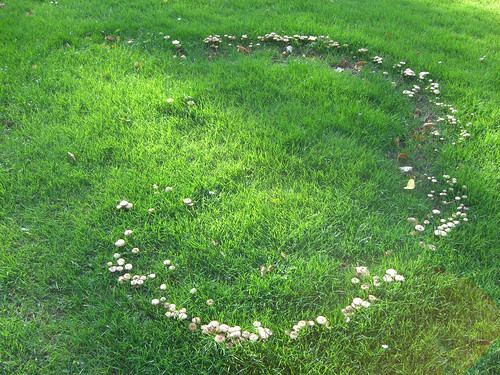
Lawn Management: Fairy rings are always a bit of a mystery to lawn owners, and have a certain mystique about them. This is no doubt spread by the particularly imaginative name, garden enthusiasts imagining strange fey creatures dancing around their lawns, creating patchy, green circles in the grass as they go. Well, with Jack’s recent theme of protecting your garden, I thought it was worth passing on a few tips on recognising the work of these tricky pests and making sure their dancing doesn’t permanently damage your lawn.
What are Fairy Rings?
The simple fact is that fairy rings are caused not by imaginary creatures, but by fungus mycelium in the soil which, as it spreads outwards, release nitrogen on the outer edges. This fungus produced nitrogen creates the flush of growth which typifies the fairy ring, displaying as an over-green, over-grown donut shaped areas of grass.
There are three types of fairy ring, imaginatively called 1, 2 and 3:
- Type 1 shows only the green ring
- Type 2 shows the green ring with mushrooms or puffballs growing around the edges
- Type 3 usually shows a double ring with burnt areas between each ring. It normally would also feature toadstools growing alongside.
What Damage can Fairy Rings Do to My Lawn?
Type 3 is the only type of fairy ring that actually causes physical damage. The main problem caused by fairy rings, however, is that as they spread outwards the mycelium left in the soil makes it hydrophobic (highly water repellent) leading to a condition called dry patch. This is a real problem as the grass roots are starved of water. Naturally, as a result of this, the grass experiences a drought and can die very quickly within these areas, turning from green to parched brown.
The only way to avoid or to attempt to cure dry patch is to ensure that water can get into the soil very easily. This can be acheived by forking or spiking the surface, creating inlets into the now hydrophobic soil. Another method is to apply a wetting agent. Simply put, that means a product that reduces the surface tension on the water droplets to let them penetrate the soil easier. There are many propriety wetting agents on the market and all will do a very good job. But, no need for that expense – an organic washing up liquid mixed in with water will do the job just as effectively and much more cheaply. You just need to make sure that you try out your particular washing up liquid on a small area of your lawn first to make sure it doesn’t harm the grass. The majority of washing up liquids will work perfectly with no harm to your lawn, but there are some that may cause mild problems and so it’s worth that early test.
How to Hide their Effects, and Ensure Fairy Rings Stay Away
Once you’ve ensured your lawn wont fall prey to dry patch, make sure you remove any mushrooms or toadstools as these are the fruiting bodies that produce more mycelium and thus permeate the growth of fairy rings. Once these are removed the problem should resolve itself in time.
As a final tip, if you really don’t like the look of fairy rings on your lawn, try applying a little more nitrogen evenly around the area. This will make the surrounding grass become more green and thus disguise the rings themselves.
I hope you found that useful and now know how to recognise and treat the fairy rings in your own garden. Good luck!
